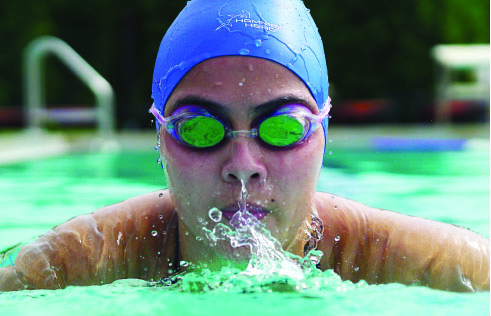
Photo: Hammer Head Swim Caps and Ramble Pictures
Innovative swim caps protect aquatic athletes.
It’s hard to imagine football, hockey or cycling without their iconic headgear. While this emphasis on protection seems obvious on land, head injuries from aquatic sports have been largely neglected, until now.
Hammer Head Swim Caps are innovative silicone caps with added impact coverage. They look and fit much like a traditional swimming cap, but include engineered protection from the trademarked “Honeycomb Impact Technology” design.
“All these other sports have a product,” says Theresa Finn, who along with swim coach David Burns founded the Hammer Head company. “We want to make aquatic sports a safer place, one cap at a time.”
Not much of a swimmer herself, Finn was brought into the world of aquatic sports by her son’s love of swimming.
“Swimming was brand new to my husband and me. At some of the meets, these kids were bonking their heads on the wall and no one even flinched,” Finn says.
The safety cap idea was sparked while Finn was at her son’s practice. While he was working in the water with the kids, coach Burns’ daughter hit her head on the end of the pool. As he was consoling her, another team member hit their head, resulting in a mild concussion, Finn says.
From there, Hammer Head was born. Finn’s husband joined in with his technical know-how, and coach Burns contributed his industry expertise. The three embarked on a journey of patents, engineering, design and manufacturing, all while maintaining full-time jobs.
“We didn’t know what we were doing,” Finn says. “It was fun, it’s been an amazing adventure, but it was tedious at times.”
While aquatics may not seem as dangerous as football or hockey, injuries, especially concussions and head impacts, can still happen, often when pools are crowded,” explains Finn.
With the unique interior “Honeycomb” webbing, the caps diffuse force, cutting back on the potential for injury and limiting pain. Made from a buttery silicone, they fit snuggly, but without uncomfortable tightness. The caps are lightweight and wrinkle-free, especially important for minimizing weight and drag in the water.
According to Hammer Head, nearly 70 percent of head injuries occur during swim practices. Hammer Head’s statistics show that 68 percent of swim injuries are from swimmers crashing into each other, the bottom of the pool or the pool wall.
In a recent study from University of California, Irvine, water polo players were surveyed, and 36 percent of players reported concussions from the sport.
“I don’t think swimming is perceived as a high injury sport. It’s not a combat sport, but it is a contact sport. I never noticed until I had a kid and was at a meet,” Finn says.
After lots of testing, prototypes, trial and error, the swim caps hit the marketplace this fall, with three size options and a variety of colors.
Finn and the Hammer Head team are also communicating with USA Swimming, the national governing body for the sport, and the organization which selects the U.S. Olympic swim team. They’ve connected with athletes, swimming clubs, and coaches to raise awareness of the swim caps and their potential for reducing injury.
Hammer Head was also featured at Minnesota Special Olympics’ 50th anniversary kickoff event, where hundreds of kids tested out the caps, says Finn. She notes that the product can especially help these athletes, both as protection and by assisting with sensory and auditory issues, since the Hammer Head cap covers the ears.
Overall, Finn aims to bring attention to head protection in aquatic sports, hoping that gear to keep athletes safe becomes the standard, both on land, and in the water.






















